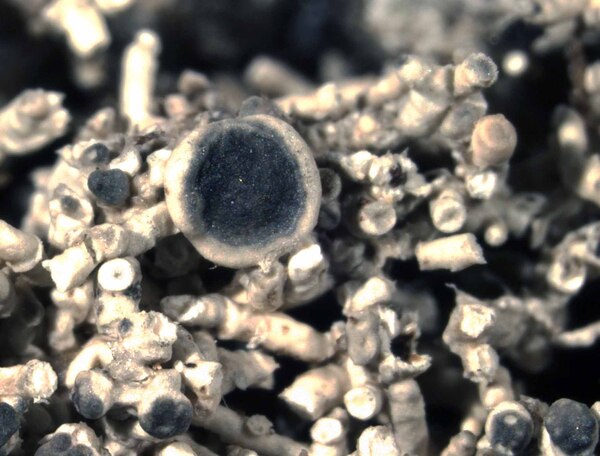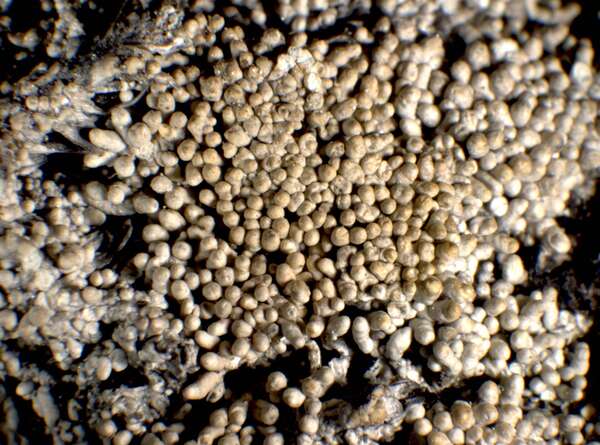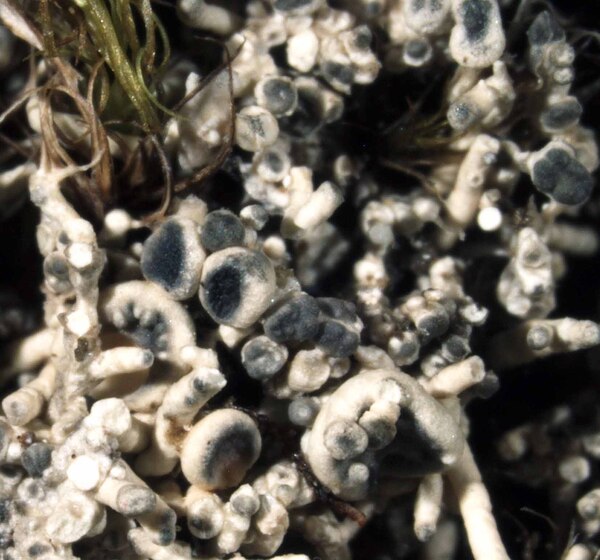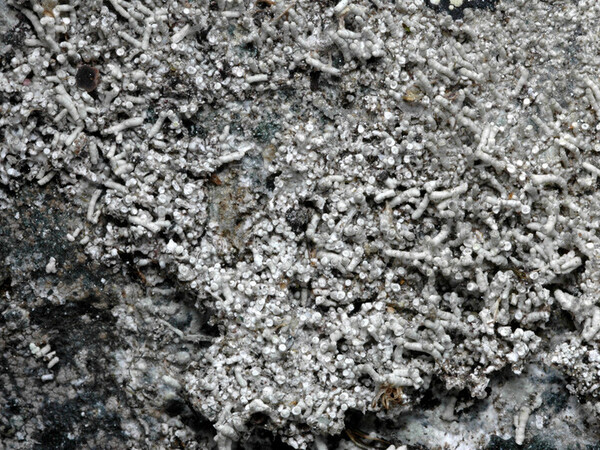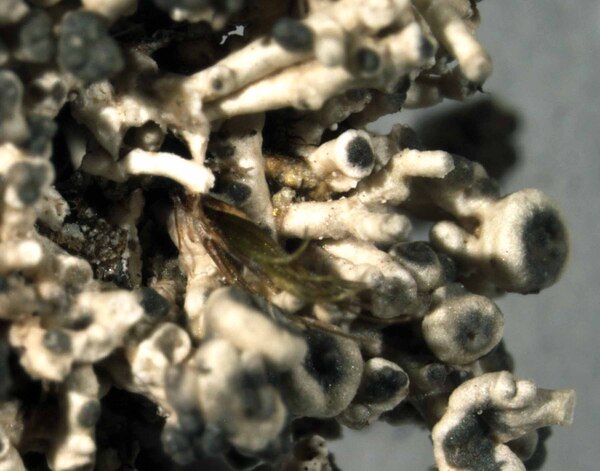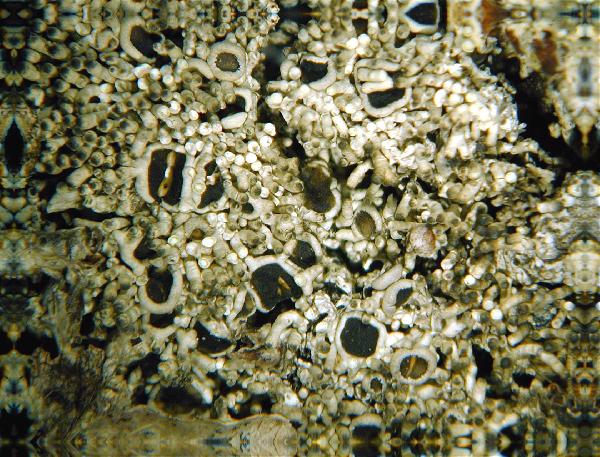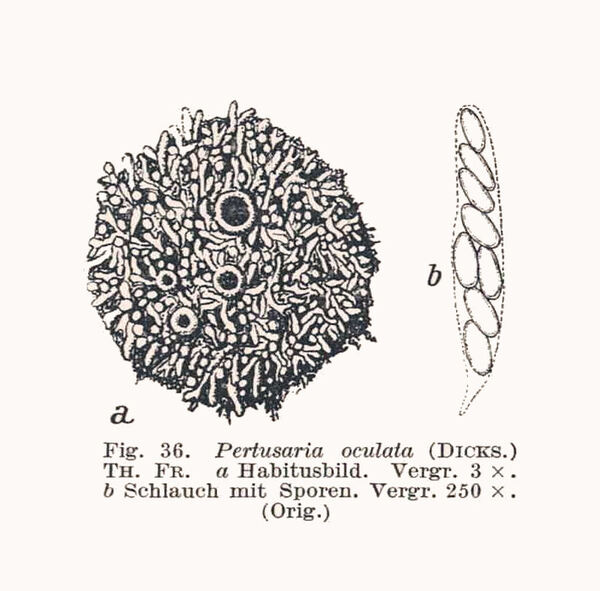Pertusaria oculata (Dicks.) Th. Fr.
Lichenogr. Scand., 1: 307, 1871. Basionym: Lichen oculatus Dicks. - Fasc. Pl. Crypt. Brit., 2: 17, 1790.
Synonyms: Lecanidium oculatum (Dicks.) A. Massal.; Lecanora oculata (Dicks.) Ach.
Distribution: N - Frl (Tretiach & Hafellner 2000), TAA (Nascimbene & al. 2022), Lomb, Piem, VA (Piervittori & Isocrono 1999), Emil (Dalle Vedove & al. 2002, Fariselli & al. 2020), Lig (Anzi, Lich. Rar. Lang. Exs. 510: S-F135384).
Description: Thallus crustose, episubstratic, rather thin, continuous, cracked or faintly tuberculate, isidiate, forming regular or irregular, up to 10 cm wide patches, without a distinct prothallus. Non-isidiate parts grey or white-grey. Isidia conspicuous, easily shedding off, concolorous with non-isidiate parts or, more often, tinged pale brown or pale yellow, simple to bifurcately branched, more or less cylindrical throughout or, occasionally, with somewhat swollen apices, 0.3-0.5 mm thick and 1-3 mm tall, often with greyish black apices reacting K+ violet, and N+ violet. Medulla distinct, white. Apothecia rare, lecanorine, up to 2.8 mm across, with a brown to black, epruinose, slightly concave to slightly convex disc and a distinct, smooth or isidiate, finally sometimes excluded thalline margin. Epithecium dark brown to black, K+ violet; hymenium colourless; paraphyses lax, richly branched and anastomosing; hypothecium pale to dark brown. Asci (6-)8-spored, broadly cylindrical, the apex with a broad ocular chamber, the outer sheath K/I+ blue, otherwise K/I-, with an inner extensible layer, Pertusaria-type. Ascospores 1-celled, hyaline, ellipsoid to fusiform, (15-)20-28(-31) x (8-)10-14(-16) µm, the wall 1-3(-6) µm thick, smooth. Pycnidia immersed in the apices of the isidia. Conidia short-bacilliform, c. 3.5 x 0.5 µm. Photobiont chlorococcoid. Spot tests: K+ yellow turning red-brown, C-, KC- or KC+ faintly yellow-red, P+ yellow turning orange-red, UV+ faintly whitish blue. Chemistry: fumarprotocetraric acid (major), protocetraric acid, sometimes gyrophoric acid (traces).Note: a circumpolar, arctic-alpine lichen found on soil and plant remains on siliceous substrata, mostly above treeline; restricted to the Alps and the Northern Apennines in Italy.
Growth form: Crustose
Substrata: soil, terricolous mosses, and plant debris
Photobiont: green algae other than Trentepohlia
Reproductive strategy: mainly asexual, by isidia, or isidia-like structures (e.g. schizidia)
Commonnes-rarity: (info)
Alpine belt: rather rare
Subalpine belt: rare
Oromediterranean belt: absent
Montane belt: absent
Submediterranean belt: absent
Padanian area: absent
Humid submediterranean belt: absent
Humid mediterranean belt: absent
Dry mediterranean belt: absent
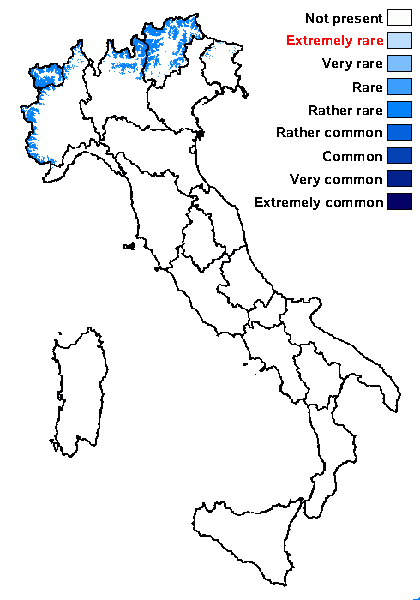
Predictive model
Herbarium samples
Growth form: Crustose
Substrata: soil, terricolous mosses, and plant debris
Photobiont: green algae other than Trentepohlia
Reproductive strategy: mainly asexual, by isidia, or isidia-like structures (e.g. schizidia)
Commonnes-rarity: (info)
Alpine belt: rather rare
Subalpine belt: rare
Oromediterranean belt: absent
Montane belt: absent
Submediterranean belt: absent
Padanian area: absent
Humid submediterranean belt: absent
Humid mediterranean belt: absent
Dry mediterranean belt: absent

Predictive model
| Herbarium samples |
 INDEX FUNGORUM
INDEX FUNGORUM
 GBIF
GBIF
 DOLICHENS
DOLICHENS
